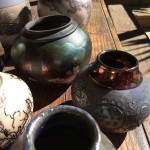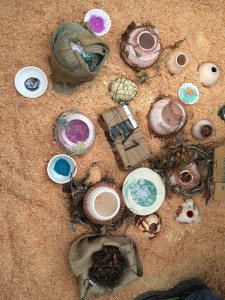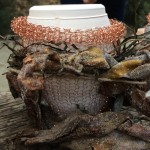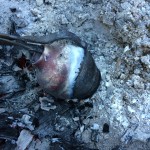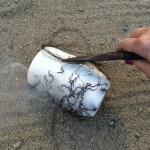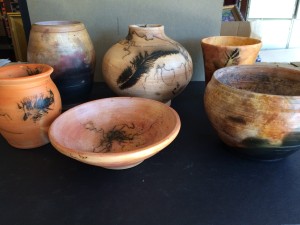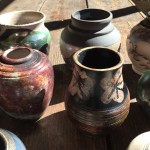Chris & Carol Webb, November 5-8, 2015, Ceramics Workshop
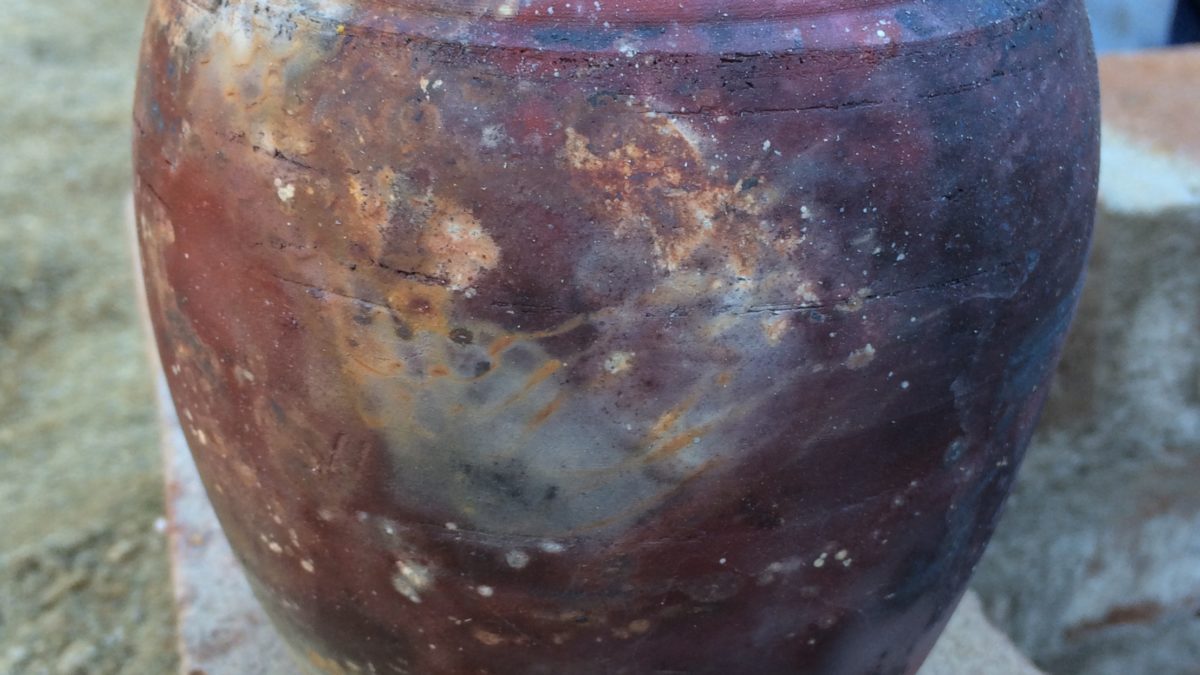
One event, Two Firing Techniques!
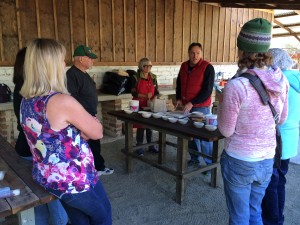
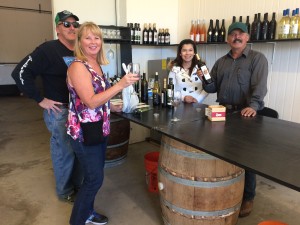
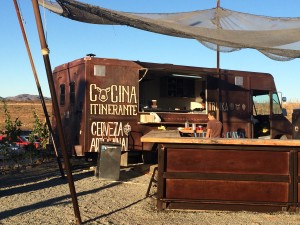
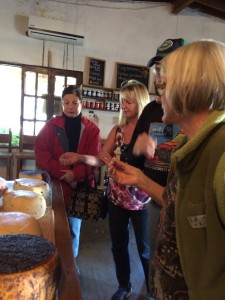
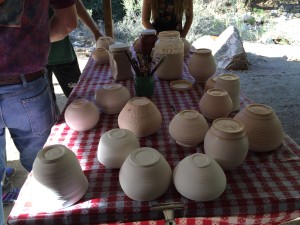
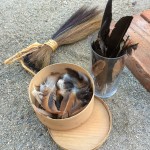
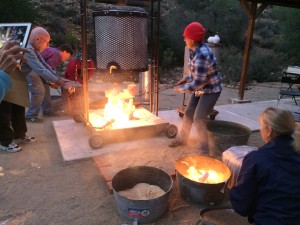
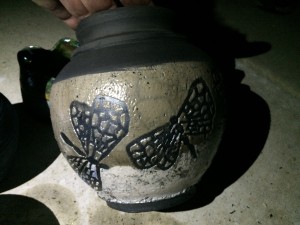
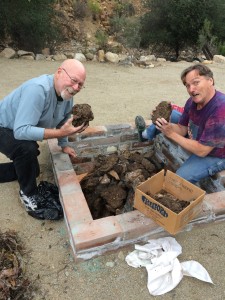
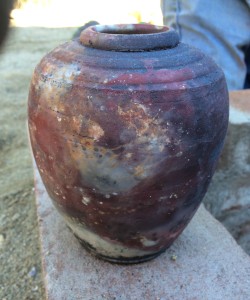
Raku and Pit Fired Pottery and Cold Finishing
Chris Webb has over twenty-five years of teaching experience and enjoys sharing his expertise by leading clay workshops for ceramic educators, art professionals, hobbyists, and novices throughout California. His wife Carol Catalano Webb teaches printmaking, but also explores cold finishes on pottery, using some of Chris’s ceramic pieces as her canvas.
On the first weekend in November 2015, we held our second Ceramic event at the Ranch. 6 guests and 2 instructors made for a very hands-on and personalized workshop. The focus of the weekend was to run several firings using different methods to create unusual color and surface designs on our clay vessels.
Christopher’s ceramic work combines both unconventional and classic forms, creative patterns, textures and the use of alternative firings such as Raku and Pit firing. Raku firing creates brilliant metallic, crackle, and smoke patterns unique to each piece. Pit firing leaves one-of-a-kind patterns on the surface, influenced by organic and inorganic materials, smoke, and flame in the firing pit. Maria Martinez of New Mexico and Juan Quezada of Mexico are world famous for their pit-fired pottery.
Friday morning Chris led us in the creation of hand built clay vessels. The traditional method of coiling and pinching the clay, and using a “pokie” to keep it round was fascinating. He showed us how to customize our pieces with lids, spouts, handles, cut designs, and stamps. By lunchtime they were ready to set aside for drying.
After some tasty tostadas, we were driven to the wine country to visit some of our favorite vineyards.
We started at El Legado, a family-owned boutique winery that focuses on two grapes, Syrah and Tempranillo; both the blends and varietals were delicious and served by family members. The casual and welcoming atmosphere complemented their wines beautifully.
Our next stop, Vena Cava, is a visual and taste treat. Owners Eileen and Phil Gregory are a busy and creative couple; some of our favorite wines in the Valle are found in this unique setting. A visit to the Vena Cava property gives visitors a memorable visual experience. The ceilings are made out of boats, and walls and doors are studded with eyeglass lenses to bring in light. It sounds crazy, but it all works to create a light and open space to enjoy great wine. And the gourmet food truck, Troika, serves up gourmet tapas!
After two tastings, we were in the mood for a nibble, and stopped at the Familia Samarin cheese shop. In business in the Valle since 1906, they are known for fine cheeses, breads, homemade jams, and desserts. They purchase a variety of cheeses from local producers, and age and flavor them in-house.
The baked chipotle cheese is incredible – you’d swear it has bacon in it, but the smoky, meaty flavor comes from baking the cheese with tomato and mild peppers for several hours…yum! That and some herb-infused cheese made it back to the Ranch in time for happy hour; it paired perfectly with one of the Big Blend red wines we’d purchased at Vena Cava.
Over dinner we discussed the plan for Saturday and Sunday.
We would select from a variety of pre-bisqued, hand built and wheel thrown items to glaze in the morning, and then take a horseback ride to allow the glazes to dry before loading the Raku kiln for the first of two Raku firings. Saturday night we would fire up the Pit and let it burn all night. Raku glazed and naked/wrapped wares would be used for the Pit firing. Combustibles supplied included oak, sawdust, straw, manure, and scrap lumber. Many unusual colorants would be used to create dynamic, one-of-a-kind finishes on the clay bodies.
Sunday morning we would dig out the Pit and clean the ware, fire a second Raku load, and experiment with horsehair and chicken feathers on hot pieces right out of the kiln. Some advance planning was needed to ensure safety and success.
Early Saturday morning I found Chris in the clay yard prepping for us. After breakfast, we gathered around to check out the raku kiln, and do a practice run. Once the kilns were red hot, each of us would have a job, and we needed to be clear on our positions and timing. While very safe if correctly orchestrated, Raku presents a unique challenge – pulling red-hot ware out of the kiln with tongs, placing them in a can of combustible material, allowing just enough time for them to ignite, then smothering the flames with the lid.
The lack of oxygen in the can puts out the flame and pulls oxygen out of the clay and glazes, resulting in unpredictable colors and smoke marks on the pottery. As the pots cool, they are dipped in water to create crackle patterns in the glazes, which enhance the colors and patterns on the pots. Raku is a traditional Japanese style of firing, and has been modified by cultures around the world to produce a variety of results. If the ware cools too much between the kiln and the smothering, the glazes won’t react. If too hot, the glazes can burn out.
Our practice was worth it – all went well in the actual moments of firing. Our results were amazing – see below!
We were certainly ready for a hearty lunch, and Paola’s chicken tacos did not disappoint…I ate more than usual, knowing we had a full afternoon ahead – horseback riding, then a pit bonfire.
As always, Raul matched each guest with a great horse, and even the less experienced riders had a wonderful time. We rode into the east canyon, and up onto the hilltops for the views of the surrounding ranchos. Such a lovely day, with more to come.
Late Saturday afternoon we prepped for the pit firing, which is a very ancient technique for firing pots without using a kiln. Rather than load a kiln, we used our brick-lined bonfire pit. We placed the combustibles in the pit right along with the wrapped ceramic objects.
Mineral powders, copper wire, banana peels, barbed wire, steel wool, string, chicken wire, seaweed, salts, charcoal briquettes, and some raku glazes were painted, splattered, or wrapped onto the pots and they were arranged in the pit in contact with these materials, all of which would leave unpredictable and distinctive colors and marks on the pots.
On top of all this, we built a large bonfire and ignited it – caution – don’t try this at home unless you have plenty of experience with the process! We watched the flames dance for an hour or so, and then the pit was left to “cook” overnight. We went to bed Saturday night knowing we’d have some surprises in the morning!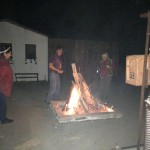
When the pit was opened Sunday before brunch, we were excited to see what the flames, smoke, and organic and inorganic materials we’d placed in the pit would do to the pots inside…we weren’t disappointed! Smoky reds, greys, and peach colors transformed the pots into works of art.
The salts from the seaweed, potassium from the banana peels, nitrogen from the dung, carbon from the briquettes, iron from the steel wool, and the copper and minerals made for an array of colors and effects on the clay.
Next, we fired up the raku kiln one more time, this time for the horsehair and feather burn. This is a real hands on process, removing hot pots from the kiln, and using tongs. rolling them or applying the carbon based items onto the hot surface. About 900 degrees is the target, a bit less than red hot this time.
I applied some color once they were cool, and here are the delightful results!
All of us took home several raku and pit fired pieces that we glazed and fired on site. Here are a few of the pieces we now own! 